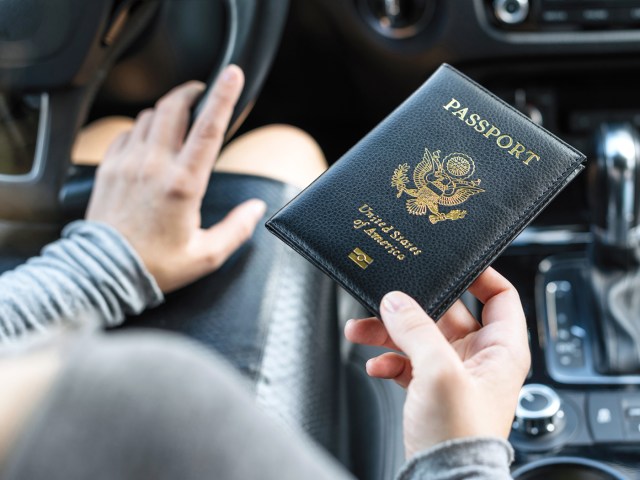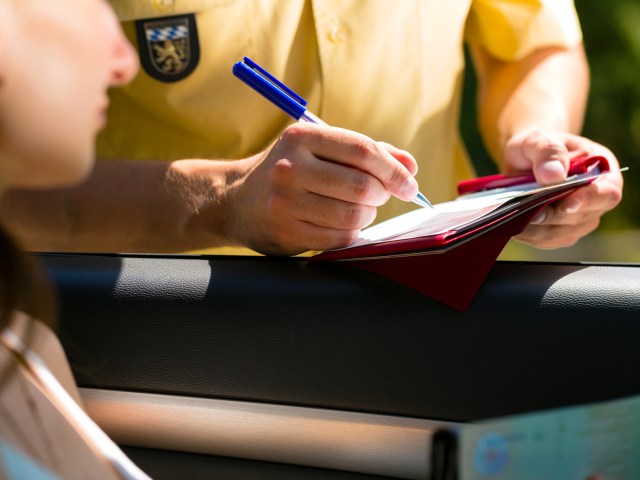Stretching 5,525 miles long, the border between the United States and Canada is the longest land border of any two nations in the world. Along that vast stretch, there are more than 100 locations where you can legally drive across the boundary. Crossing the border by car is simple, as long as you come prepared with the necessary documentation and an awareness of all the rules and regulations. Here’s what you need to know before driving over the U.S.-Canada border.
Prepare Your Travel Documents

Having the proper travel documents on hand is essential no matter which direction you’re going. A passport is generally considered to be the gold standard for crossing the border, whether by car or otherwise. But when crossing into Canada, there are some differences depending on if you’re a resident of the United States or elsewhere.
U.S. citizens can use a passport card or enhanced driver’s license to enter Canada, so you can leave your bulky passport at home in favor of these wallet-sized IDs. Children under 16 require only proof of U.S. citizenship, such as a birth certificate, and there are other considerations for minors traveling without both parents or legal guardians, which you can review here.
If you’re not a U.S. citizen, you may need to acquire a visa before coming in — check here to determine your personal visa requirements and eligibility. There’s also an exception for Indigenous peoples entering Canada. The Indian Act allows entry for those who show a status card or other documents proving membership in a federally recognized tribe. If you’re a Canadian citizen returning to the country, you will need to show your Canadian passport upon reentry.
When heading the other direction, into the U.S., the process is largely similar. Passport or passport cards are the quickest way to prove your identity to the border agent. Canadian citizens under the age of 15 who don’t yet possess a passport should come prepared with a birth certificate or Canadian citizenship card, but anyone 16 years or older must travel with a valid passport.
Provide Accurate Info and Declare Goods

When crossing the border, expect to be asked several questions about your citizenship status, where you’ll be visiting, how long you plan to spend there, and who you’ll be meeting. As long as you respond truthfully and accurately, your answers should be enough to satisfy the border guard.
One question that often throws people off is declaring goods. U.S. citizens must declare all goods they bring with them. When returning to the United States, purchases made in Canada up to $800 USD remain duty-free, while any goods with a value between $800 and $1,800 USD are subject to a 4% duty rate. For those returning to Canada, you can claim goods valued up to $200 CAD without having to pay duties or taxes for visits of at least 24 hours, and up to $800 CAD for visits longer than 48 hours. However, there are additional rules to be aware of regarding items such as alcohol and tobacco.
You’ll also need to declare any items that could be prohibited by the country you’re entering; if you don’t, you may be subject to significant fines or jail time. Plants, animals, food, and drinks must be declared, as there are concerns over the potential for bringing in parasites and disease. You also must announce any firearms or explosives; if you don’t, these items can be seized and you may be denied entry. Lastly, be sure to declare any currency in excess of $10,000 CAD or USD. A list of further restrictions for traveling into Canada can be found here, while a list of prohibited items in the United States can be found here.
Check Wait Times and Hours

During peak hours or on busy days of the year, border crossings may become clogged with traffic. That’s why you should check wait times at the border before hitting the road, so you can switch up your route and choose a less congested option if need be.
It’s also important to be aware that some crossings, especially those in less trafficked areas, are not open 24 hours a day or seven days a week. Check this map to learn more about the border crossings that are closest to you and when they’re expected to be open. Additionally, travelers can enroll in the NEXUS program, which is designed to reduce wait times at land border crossings for prescreened travelers.
Traveling With a Pet?

Both the U.S. and Canada have strict guidelines for bringing pets into the country. Rules depend on the type of animal, the purpose it’s being transported for, and other factors such as age and vaccination status. The Canadian government provides a helpful online tool where you can input information about the specific animal you’re traveling with. Depending on the information you provide, you may be told to bring certain veterinary records.
The United States Animal and Plant Health Inspection Service provides a similar set of guidelines with information regarding each specific animal that you may be hoping to bring over the border. Be truthful when filling out the forms, as there will be no leniency at the border if you fail to follow the required guidelines.
Inadmissibility Into Canada

Like in other countries, Canadian border agents may deny anyone entry for security reasons or if they pose a threat to others. However, Canada is especially strict for certain past offenses. For instance, border agents may deem you inadmissible if you’ve ever been convicted of driving under the influence of alcohol or drugs.
Even if the offense occurred decades ago, you may still be denied entry into Canada for a past DUI or DWI conviction. That said, there are several courses of action you can take to possibly gain entry, including applying for a temporary resident permit or criminal rehabilitation. Be aware that both of those applications come at a financial cost and neither is guaranteed to be successful.
More from our network
Daily Passport is part of Inbox Studio, which publishes content that uplifts, informs, and inspires.
















